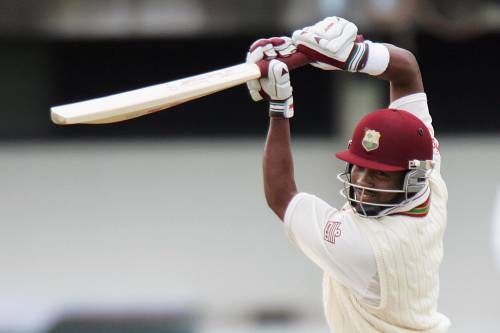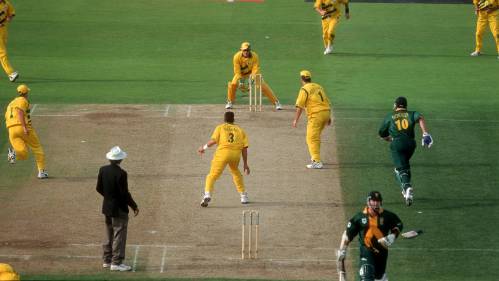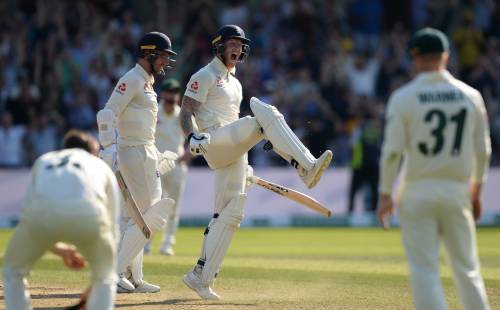Iconic Sporting Moments
Welcome back to Fixture’s Iconic Sporting Moments Series. Next up it’s cricket. From incredible Test series to moments of individual brilliance, dramatic comebacks to thrilling underdog triumphs, here are a selection of moments that prove why cricket is one of the most compelling sports in the world.
 The Birth of the Ashes, 1882
The Birth of the Ashes, 1882
England and Australia played a one-off Test match in 1882, and the reaction to the result was the catalyst for the most illustrious Test series in world cricket. After Australia inflicted a shock seven-run defeat on England, journalist Reginald Shirley Brooks wrote: “In affectionate remembrance of English cricket which died at The Oval, 29th August 1882… The body will be cremated and the Ashes taken to Australia.” The pair met again the following winter in a three-Test series, which England won 2-1. According to legend, a small urn containing the ashes of a bail used in the third test was presented to England captain Ivo Bligh. England and Australia have since competed for the Ashes every couple of years in the highlight of the cricketing calendar and a replica of the urn has been awarded to the series’ winners since 1999. The original urn was donated to the Marleybone Cricket Club at Lord’s in 1927, where it has remained ever since.
Underdogs India Win the World Cup and Trigger Country’s Love Affair with Cricket, 1983
India were 50-1 outsiders at the beginning of the 1983 World Cup - during the previous two World Cups they had recorded one solitary victory. They looked as if they could be heading for their usual early exit when they found themselves 9/4 against Zimbabwe in their penultimate group match, only for captain Kapil Dev to score a mammoth 175 in an astonishing innings to secure a 31-run victory. It was a turning point in India’s tournament, as they comprehensively beat Australia in their final group match, before eliminating hosts England in the semifinals. In the final, India faced an imperious West Indies side, captained by the great Viv Richards, who were on the hunt for their third successive World Cup crown. The West Indies were on track to secure it after India were bowled all out for 183 but the India bowling line-up were in inspired form, and the Windies were all out for 140 and India were crowned world champions. It was a tournament that transformed Indian cricket, the nation became transfixed and this inaugural World Cup victory was the first step towards the dominance they would go onto enjoy in the game.
Shane Warne’s Ball of the Century - Australia v England, 1993 Ashes
Australia bowler Shane Warne retired from international cricket in 2006, safe in the knowledge that he had forged a legacy as one of the greatest bowlers to ever grace the field. Warne announced himself on the international stage during the 1993 Ashes series. It was the then 23-year-old’s Ashes debut, and yet he finished the series as the leading wicket taker. On the second day of the first Test at Old Trafford, in the very first ball Warne ever bowled in the Ashes, he dismissed England batsman Mike Gatting for four, with one of the finest pieces of spin bowling the game has ever seen. The ball pitched several inches wide of Gatting’s leg stump, before sharply swerving inside and clipping it, leaving the England batsman completely deceived by the outrageous spin on the ball. An absolutely mesmerising piece of bowling.
 England Win World Cup With Dramatic Super Over, 2019
England Win World Cup With Dramatic Super Over, 2019
Sport is all about fine margins, and the 2019 Cricket World Cup final was decided by the very finest. Hosts, England, looked to be on course to secure a maiden World Cup title after being set a modest 241 by New Zealand, but the Black Caps fared better with the ball, stifling the England batsmen and leaving them requiring 46 with five overs remaining. With a bit of Ben Stokes’ brilliance - hitting 86 to drag England back into contention - and a slice of fortune - Stokes scored an extra four runs as he dived for the crease and Martin Guptill’s attempted return to the wicketkeeper’s end deflected off his bat - England drew level to send the final to a Super Over, the first time an ODI had to be settled by such a means. Remarkably, the two sides were still level after the Super Over, having scored 15 runs a piece, but England were crowned world champions by virtue of scoring more boundaries. Cricket’s showpiece event delivered one of the tightest, most enthralling games the sport has ever seen.
 Brian Lara Hits Record Breaking 375 Against England, 1994
Brian Lara Hits Record Breaking 375 Against England, 1994
In April 1994, West Indies batsman Brian Lara broke a 36-year-old world record courtesy of a stunning individual display. The West Indies had already won the Test series against England when Lara took to the crease in the fifth Test with the score 11-1 and where he would remain for an outstanding 12 hours and 46 minutes. He hit 45 fours on his way to scoring a record breaking 375 runs off 538 balls. When Lara hit a four to surpass compatriot Garfield Sobers’ record of 365, fans clambered over the fence and poured onto the pitch in celebration. This record would stand for nearly a decade, before Australia’s Matthew Hayden came along and eclipsed it in 2003 with a score of 380. However, just six months later, the record was Lara’s once more, when he hit an unbeaten 400 against the very same opponent in the very same venue - St John’s Antigua - to re-confirm his place in the Test cricket history books.
 Australia Beat South Africa in Dramatic World Cup Semi Final, 1999
Australia Beat South Africa in Dramatic World Cup Semi Final, 1999
With a place in the Cricket World Cup final at stake, South Africa and Australia served up one of the greatest ODI matches in the sport’s history. The Australian top order initially struggled, but Steve Waugh and Michael Bevan stepped up to steady the Australia ship, and their side eventually finished with a respectable but catchable 213. After getting off to a similarly slow start with the bat, Jacque Kallis and Jonty Rhodes’ 84-run partnership dragged South Africa back into contention. They were left requiring nine runs from the final over to reach their maiden World Cup final. Lance Klusner hit two boundaries from the first two balls to leave South Africa within one run of making history. On the fourth delivery, Klusner tapped the ball and set off for a single, but non-striker Allan Doland remained rooted to the crease. He ran too late and was run out, leaving the match tied at 213 runs each. Australia made it to the final on the virtue of having beaten South Africa earlier in the tournament; an elimination in the cruelest, most dramatic fashion.
The Gripping 2005 Ashes Series
Steeped in history, tradition and ancient rivalry, Test series do not come any bigger than the Ashes. The 2005 series more than lived up to its billing, producing two and a half months of pulsating cricket. Australia had possessed one of the sport’s greatest ever sides throughout the 90s and early 2000s, and as a result had held the urn for 16 years. It looked as if the 2005 series was going to follow a similar pattern after they won the first Test by 239 runs. However, England fought back in the second Test at Edgbaston, an enthralling match that ebbed and flowed, momentum swinging one way and then the other, with the hosts eventually winning by two runs - the smallest margin of victory in Ashes history. A solid draw at Old Trafford followed, before England secured yet another nail-biting win in a thrilling fourth Test at Trent Bridge, as the lower order of Ashley Giles and Matthew Hoggard edged them over the line. Bad light meant the fifth Test ended in a draw, and the most dramatic series in Ashes history concluded with England regaining the urn for the first time since 1987.
 India Complete Comeback Victory Over Australia, 2001
India Complete Comeback Victory Over Australia, 2001
Australia looked in prime position to take a 2-0 lead in their 2001 Test series against India, after hitting 445 runs and bowling the hosts all out for just 171. Australia captain, Steve Waugh, then opted to enforce the follow on - meaning India went back in to bat - and the fightback began. VVS Laxman hit a huge 281, and the hosts eventually declared on 657 for seven in the morning of the final day, leaving the tourists two and a half sessions to bat through to secure a draw. Australia looked on course to be doing just that, putting on 74 runs for the first wicket. However, once that fell, the wickets started tumbling. Captain Waugh briefly steadied the ship, but after he was dismissed the Australia resistance started crumbling. Glenn McGrath and Michael Kasprowicz kept India at bay for a good half an hour, until the former was eventually trapped in front of the stumps to complete a famous India comeback victory from the jaws of near-certain defeat.
 Ben Stokes’ Headingley Innings, 2019 Ashes
Ben Stokes’ Headingley Innings, 2019 Ashes
Ben Stokes enjoyed quite the year in 2019. Just 41 days after guiding his country to World Cup glory, he produced one of the most astounding individual performances to singlehandedly draw England level in the third test of the 2019 Ashes. England were staring down the barrel of defeat after being bowled out for a mere 67 in the first innings, leaving them chasing a seemingly insurmountable 359 in the second innings. When Stokes came to the crease, England still required another 218. In a stunning solo display, he hit an unbeaten 135, forming a partnership of 76 with Jack Leach (who scored one) to lead England to victory and keeping their Ashes hopes alive. Stokes hit eleven fours and eight sixes, hope growing among the home crowd with each boundary that the near impossible could be achieved. His final 84 runs came from just 67 balls. It was fearless, heroic and utterly breath-taking.
South Africa belittle Australia’s 434, 2006
South Africa and Australia have a history of producing spectacular ODI encounters. In the final match of the five-game series in 2006, Australia captain Ricky Pointing hit 164 off 105 balls to help his side break the 400 mark for the first time in ODI history. Australia set South Africa a seemingly unattainable 434, but the hosts rose to the challenge, Herschelle Gibbs hitting an astonishing 175 off 111. Mark Boucher sent the penultimate ball to the boundary to leave South Africa 438-4, securing an astounding win and giving them a 3-2 series victory. Prior to the match, no ODI side had ever broken the 400 barrier in the history of the game. Australia and South Africa both pulled off the remarkable feat on the same day, treating the crowd to a staggering 872 runs. It was cricket at its most unpredictable and mesmerising best.
These are just a selection of cricket’s most iconic moments, with the sport serving up various other pieces of magic throughout history; from moments of individual brilliance such as Don Bradman’s incredible 334 for Australia against England in the 1930 Ashes, to Sachin Tendulkar making history as the first man to score 200 in an ODI against South Africa in 2010. From great teams, such as the brilliant Pakistan side of 1992 who triumphed in the World Cup for the first time in their history, to the plucky Sri Lanka underdogs who shocked the cricketing world as they won the same competition four years later. Also including thrilling Tests, such as Ian Botham’s inspired performance in England’s astonishing 1981 comeback victory over Australia at Edgbaston. Cricket always has and always will enthral, entertain and amaze. Make sure you never miss a Test, ODI or T20 with the Fixture Calendar.
Written in July 2020
Photos by Lord's Cricket Ground, Cricket World Cup 2019, ICC Cricket, ICC Cricket, ICC Cricket, ICC Cricket